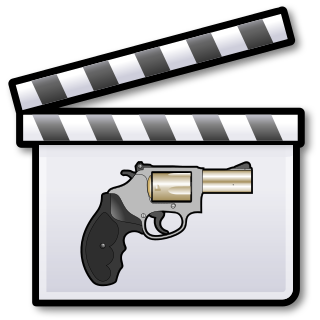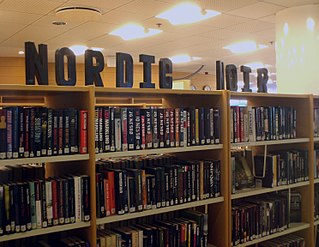
Film noir is a cinematic term used primarily to describe stylized Hollywood crime dramas, particularly those that emphasize cynical attitudes and motivations. The 1940s and 1950s are generally regarded as the "classic period" of American film noir. Film noir of this era is associated with a low-key, black-and-white visual style that has roots in German Expressionism cinematography. Many of the prototypical stories and attitudes expressed in classic noir derive from the hardboiled school of crime fiction that emerged in the United States during the Great Depression.

Crime fiction, detective story, murder mystery, mystery novel, and police novel are terms used to describe narratives that centre on criminal acts and especially on the investigation, either by an amateur or a professional detective, of a crime, often a murder. Most crime drama focuses on criminal investigation and does not feature the courtroom. Suspense and mystery are key elements that are nearly ubiquitous to the genre.

Crime films, in the broadest sense, is a film genre inspired by and analogous to the crime fiction literary genre. Films of this genre generally involve various aspects of crime and its detection. Stylistically, the genre may overlap and combine with many other genres, such as drama or gangster film, but also include comedy, and, in turn, is divided into many sub-genres, such as mystery, suspense or noir. It also includes mafia dramas.

Ted Lewis was a British writer known for his crime fiction.

Palgrave Macmillan is a British academic and trade publishing company headquartered in the London Borough of Camden. Its programme includes textbooks, journals, monographs, professional and reference works in print and online. It maintains offices in London, New York, Shanghai, Melbourne, Sydney, Hong Kong, Delhi and Johannesburg.

Tech-noir is a hybrid genre of fiction, particularly film, combining film noir and science fiction, epitomized by Ridley Scott's Blade Runner (1982) and James Cameron's The Terminator (1984). The tech-noir presents "technology as a destructive and dystopian force that threatens every aspect of our reality".
Suburban Gothic is a subgenre of Gothic fiction, art, film and television, focused on anxieties associated with the creation of suburban communities, particularly in the United States and the Western world, from the 1950s and 1960s onwards.

Gunnar Staalesen is a Norwegian writer. He is a major figure in the Nordic noir crime fiction genre through his 19 novels featuring Varg Veum, a private detective in Bergen on the rainy west coast of Norway. The Varg Veum series has been praised as one of the best in modern crime fiction, and Staalesen has sold more than 4 million books in 24 countries. Staalesen is also a screenwriter and a playwright who has worked extensively with Den Nationale Scene, the largest theatre in Bergen.
Kenneth Martin Edwards is a British crime novelist, whose work has won multiple awards including lifetime achievement awards for his fiction, non-fiction, short fiction, and scholarship in the UK and the United States. In addition to translations into various European languages, his books have been translated into Japanese, Chinese, Korean, and Taiwanese. As a crime fiction critic and historian, and also in his career as a solicitor, he has written non-fiction books and many articles. He is the current President of the Detection Club and in 2020 was awarded the Crime Writers' Association's Diamond Dagger, the highest honour in British crime writing, in recognition of the "sustained excellence" of his work in the genre.

Pam Cook is Professor Emerita in Film at the University of Southampton. She was educated at Sir William Perkins's School, Chertsey, Surrey and Birmingham University, where she was taught by Stuart Hall, Richard Hoggart, Malcolm Bradbury, and David Lodge. Along with Laura Mulvey and Claire Johnston, she was a pioneer of 1970s Anglo-American feminist film theory. Her collaboration with Claire Johnston on the work of Hollywood film director Dorothy Arzner provoked debate among feminist film scholars over the following decades.

Urban Gothic is a sub-genre of Gothic fiction, film horror, and television dealing with industrial and post-industrial urban society. It was pioneered in the mid-19th century in Britain, Ireland, and the United States, before being developed in British novels such as Robert Louis Stevenson's Strange Case of Dr Jekyll and Mr Hyde (1886) and Irish novels such as Oscar Wilde's The Picture of Dorian Gray (1890) and Bram Stoker's Dracula (1897). In the twentieth century, urban Gothic influenced the creation of the sub-genres of Southern Gothic and suburban Gothic. From the 1980s, interest in the urban Gothic was revived with books like Anne Rice's Vampire Chronicles and a number of graphic novels that drew on dark city landscapes, leading to adaptations in film including Batman (1989), The Crow (1994) and From Hell (2001), as well as influencing films like Seven (1995).
Ginette Vincendeau is a French-born British-based academic who is a professor of film studies at King's College London.

They Drive By Night is the second novel by British author James Curtis published in 1938. It is a crime thriller set in 1930s London and the North of England dealing with working-class themes in a Social realism style.
Daniel Birt was an English film director and editor.

Nordic noir, also known as Scandinavian noir, is a genre of crime fiction usually written from a police point of view and set in Scandinavia or the Nordic countries. Nordic noir often employs plain language, avoiding metaphor, and is typically set in bleak landscapes. This results in a dark and morally complex mood, in which a tension is depicted between the apparently still and bland social surface and the patterns of murder, misogyny, rape, and racism the genre depicts as lying underneath. It contrasts with the whodunit style such as the English country house murder mystery.
This is a bibliography of reference works on film by genre.
A list of reference works on the horror genre of film.
John Edgar Browning is an American author, editor, and scholar known for his nonfiction works about the horror genre, Dracula, and vampires in film, literature, and culture. Previously a visiting lecturer at the Georgia Institute of Technology, he is now a professor of liberal arts at the Savannah College of Art and Design in Atlanta, Georgia.

A Gothic film is a film that is based on Gothic fiction or common elements from such fictional works. Since various definite film genres—including science fiction, film noir, thriller, and comedy—have used Gothic elements, the Gothic film is challenging to define clearly as a genre. Gothic elements have especially infused the horror film genre, contributing supernatural and nightmarish elements.

Body horror, or biological horror, is a subgenre of horror fiction that intentionally showcases grotesque or psychologically disturbing violations of the human body or to any other creature. These violations may manifest through aberrant sex, mutations, mutilation, zombification, gratuitous violence, disease, or unnatural movements of the body. Body horror was a description originally applied to an emerging subgenre of North American horror films, but has roots in early Gothic literature and has expanded to include other media.












